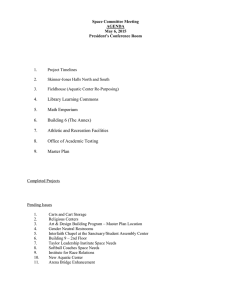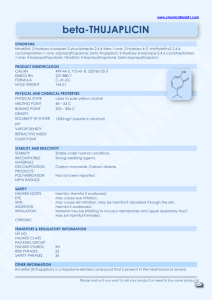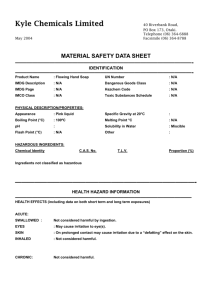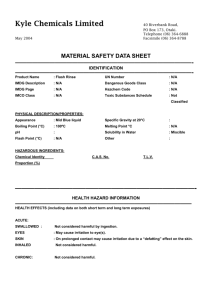w76459 3 x a diesel e05.00 en
advertisement
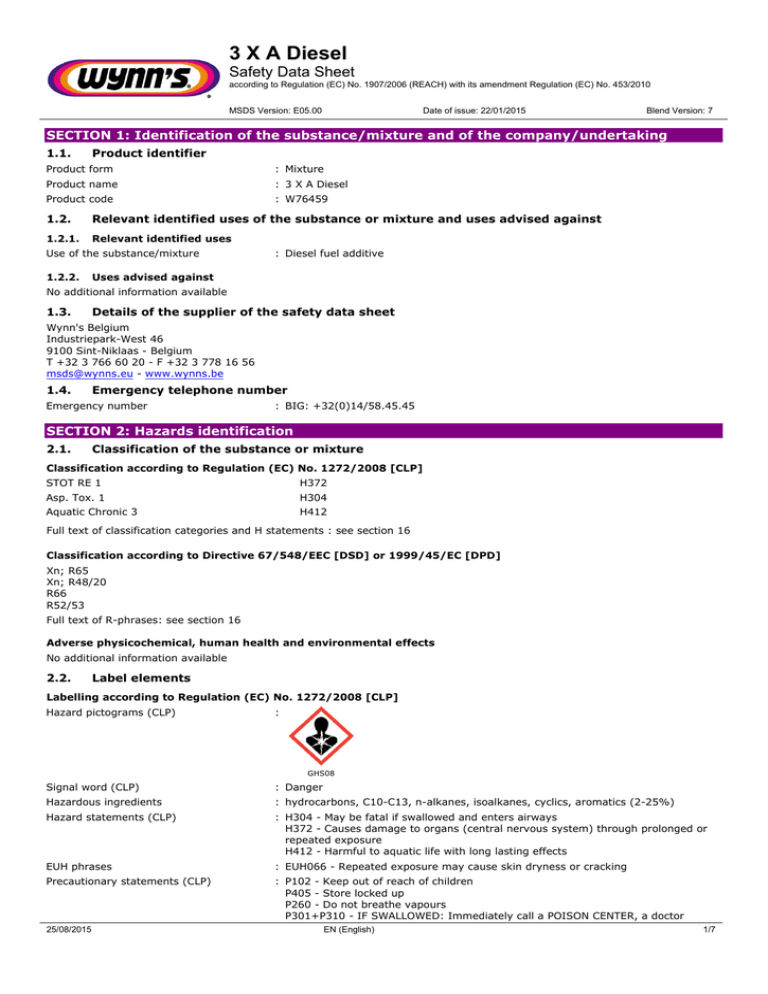
3 X A Diesel Safety Data Sheet according to Regulation (EC) No. 1907/2006 (REACH) with its amendment Regulation (EC) No. 453/2010 MSDS Version: E05.00 Date of issue: 22/01/2015 Blend Version: 7 SECTION 1: Identification of the substance/mixture and of the company/undertaking 1.1. Product identifier Product form : Mixture Product name : 3 X A Diesel Product code : W76459 1.2. Relevant identified uses of the substance or mixture and uses advised against 1.2.1. Relevant identified uses Use of the substance/mixture 1.2.2. : Diesel fuel additive Uses advised against No additional information available 1.3. Details of the supplier of the safety data sheet Wynn's Belgium Industriepark-West 46 9100 Sint-Niklaas - Belgium T +32 3 766 60 20 - F +32 3 778 16 56 msds@wynns.eu - www.wynns.be 1.4. Emergency telephone number Emergency number : BIG: +32(0)14/58.45.45 SECTION 2: Hazards identification 2.1. Classification of the substance or mixture Classification according to Regulation (EC) No. 1272/2008 [CLP] STOT RE 1 H372 Asp. Tox. 1 H304 Aquatic Chronic 3 H412 Full text of classification categories and H statements : see section 16 Classification according to Directive 67/548/EEC [DSD] or 1999/45/EC [DPD] Xn; R65 Xn; R48/20 R66 R52/53 Full text of R-phrases: see section 16 Adverse physicochemical, human health and environmental effects No additional information available 2.2. Label elements Labelling according to Regulation (EC) No. 1272/2008 [CLP] Hazard pictograms (CLP) : Signal word (CLP) : Danger Hazardous ingredients : hydrocarbons, C10-C13, n-alkanes, isoalkanes, cyclics, aromatics (2-25%) Hazard statements (CLP) : H304 - May be fatal if swallowed and enters airways H372 - Causes damage to organs (central nervous system) through prolonged or repeated exposure H412 - Harmful to aquatic life with long lasting effects EUH phrases : EUH066 - Repeated exposure may cause skin dryness or cracking Precautionary statements (CLP) : P102 - Keep out of reach of children P405 - Store locked up P260 - Do not breathe vapours P301+P310 - IF SWALLOWED: Immediately call a POISON CENTER, a doctor GHS08 25/08/2015 EN (English) 1/7 3 X A Diesel Safety Data Sheet according to Regulation (EC) No. 1907/2006 (REACH) with its amendment Regulation (EC) No. 453/2010 P331 - Do NOT induce vomiting P273 - Avoid release to the environment 2.3. Other hazards No additional information available SECTION 3: Composition/information on ingredients 3.1. Substance Not applicable 3.2. Mixture Name Product identifier %w Classification according to Directive 67/548/EEC hydrocarbons, C10-C13, n-alkanes, isoalkanes, cyclics, aromatics (2-25%) (EC no) 919-164-8 (REACH-no) 01-2119473977-17 >= 90 Xn; R48/20 Xn; R65 R66 2-Ethylhexyl nitrate (CAS No) 27247-96-7 (EC no) 248-363-6 (REACH-no) 01-2119539586-27 5 - 10 Xn; R20/21/22 R44 N; R51/53 R66 Distillates (petroleum), hydrotreated light (CAS No) 64742-47-8 (EC no) 265-149-8 (EC index no) 649-422-00-2 (REACH-no) 01-2119484819-18 1 - 2,5 Xn; R65 R66 Hydrocarbons, C10, aromatics, <1% naphthalene (EC no) 918-811-1 (REACH-no) 01-2119463583-34 0,1 - 1 N; R51/53 Xn; R65 R66 R67 Name Product identifier Specific concentration limits 2-Ethylhexyl nitrate (CAS No) 27247-96-7 (EC no) 248-363-6 (REACH-no) 01-2119539586-27 (C >= 10) R44 Name Product identifier %w Classification according to Regulation (EC) No. 1272/2008 [CLP] hydrocarbons, C10-C13, n-alkanes, isoalkanes, cyclics, aromatics (2-25%) (EC no) 919-164-8 (REACH-no) 01-2119473977-17 >= 90 STOT RE 1, H372 Asp. Tox. 1, H304 Aquatic Chronic 3, H412 2-Ethylhexyl nitrate (CAS No) 27247-96-7 (EC no) 248-363-6 (REACH-no) 01-2119539586-27 5 - 10 Acute Tox. 4 (Oral), H302 Acute Tox. 4 (Dermal), H312 Acute Tox. 4 (Inhalation:dust,mist), H332 Aquatic Chronic 2, H411 Distillates (petroleum), hydrotreated light (CAS No) 64742-47-8 (EC no) 265-149-8 (EC index no) 649-422-00-2 (REACH-no) 01-2119484819-18 1 - 2,5 Asp. Tox. 1, H304 Hydrocarbons, C10, aromatics, <1% naphthalene (EC no) 918-811-1 (REACH-no) 01-2119463583-34 0,1 - 1 STOT SE 3, H336 Asp. Tox. 1, H304 Aquatic Chronic 2, H411 Full text of R- and H-statements: see section 16 SECTION 4: First aid measures 4.1. Description of first aid measures First-aid measures general : Check the vital functions. Keep victim at rest in half upright position. Unconscious: maintain adequate airway and respiration. Respiratory arrest: artificial respiration or oxygen. Cardiac arrest: perform resuscitation. Vomiting: prevent asphyxia/aspiration pneumonia. Victim in shock: on his back with legs slightly raised. Prevent cooling by covering the victim (no warming up). Keep watching the victim. Give psychological aid. Keep the victim calm, avoid physical strain. If necessary seek medical advice. First-aid measures after inhalation : If breathing is difficult, remove victim to fresh air and keep at rest in a position comfortable for breathing. Call a POISON CENTER or doctor/physician if you feel unwell. 25/08/2015 EN (English) 2/7 3 X A Diesel Safety Data Sheet according to Regulation (EC) No. 1907/2006 (REACH) with its amendment Regulation (EC) No. 453/2010 First-aid measures after skin contact : After contact with skin, take off immediately all contaminated clothing, and wash immediately with plenty of water and soap. If skin irritation occurs: Get medical advice/attention. First-aid measures after eye contact : IF IN EYES: Rinse cautiously with water for several minutes. Remove contact lenses, if present and easy to do. Continue rinsing. If eye irritation persists: Get medical advice/attention. First-aid measures after ingestion : Rinse mouth. Do NOT induce vomiting. In the event of faintness, seek medical advice. Ingestion of large quantities: immediately to hospital. 4.2. Most important symptoms and effects, both acute and delayed Symptoms/injuries after skin contact : Repeated or prolonged skin contact may cause dermatitis and defatting. Symptoms/injuries after ingestion : Headache. Abdominal pain. Risk of aspiration pneumonia. May be fatal if swallowed and enters airways. 4.3. Indication of any immediate medical attention and special treatment needed No additional information available SECTION 5: Firefighting measures 5.1. Extinguishing media Suitable extinguishing media 5.2. : Water spray. AFFF foam. ABC-powder. Special hazards arising from the substance or mixture Fire hazard : Combustible liquid. This material can accumulate static charge by flow or agitation and can be ignited by static discharge. Explosion hazard : No direct explosion hazard. 5.3. Advice for firefighters Firefighting instructions : Prevent fire-fighting water from entering environment. Protection during firefighting : Do not enter fire area without proper protective equipment, including respiratory protection. SECTION 6: Accidental release measures 6.1. Personal precautions, protective equipment and emergency procedures General measures 6.1.1. : Use special care to avoid static electric charges. No open flames. No smoking. For non-emergency personnel Protective equipment : Safety glasses. Face-shield. Gloves. protective clothing. Emergency procedures : Mark the danger area. Seal off low-lying areas. Large spills/in enclosed spaces: compressed air apparatus. Wash contaminated clothes. 6.1.2. For emergency responders Protective equipment 6.2. : Equip cleanup crew with proper protection. Environmental precautions Prevent entry to sewers and public waters. Avoid release to the environment. 6.3. Methods and material for containment and cleaning up For containment : Contain leaking substance, pump over in suitable containers. Methods for cleaning up : Small quantities of liquid spill: take up in non-combustible absorbent material and shovel into container for disposal. Small quantities of liquid spill: take up in noncombustible absorbent material and shovel into container for disposal. Clean with detergents. Avoid solvent cleaners. 6.4. Reference to other sections No additional information available SECTION 7: Handling and storage 7.1. Precautions for safe handling Precautions for safe handling : Meets the legal requirements. Repeated or prolonged contact with the product may lead to removal of natural fats from the skin. Presents no particular risk when handled in accordance with good occupational hygiene practice. Hygiene measures : Use good personal hygiene practices. Wash contaminated clothing before reuse. 7.2. Conditions for safe storage, including any incompatibilities Storage conditions 25/08/2015 : Meets the legal requirements. Keep container tightly closed. Protect from sunlight. Store in a well-ventilated place. EN (English) 3/7 3 X A Diesel Safety Data Sheet according to Regulation (EC) No. 1907/2006 (REACH) with its amendment Regulation (EC) No. 453/2010 Storage temperature : < 45 °C Storage area : Meets the legal requirements. Keep container tightly closed in a cool, wellventilated place. Ventilation along the floor. Special rules on packaging : Keep only in original container. correctly labelled. 7.3. Specific end use(s) No additional information available SECTION 8: Exposure controls/personal protection 8.1. Control parameters hydrocarbons, C10-C13, n-alkanes, isoalkanes, cyclics, aromatics (2-25%) Italy - Portugal - USA ACGIH ACGIH TWA (ppm) 100 ppm Distillates (petroleum), hydrotreated light (64742-47-8) Belgium Limit value (mg/m³) 200 mg/m³ Italy - Portugal - USA ACGIH ACGIH TWA (mg/m³) 200 mg/m³ 8.2. Exposure controls Appropriate engineering controls : Emergency eye wash fountains and safety showers should be available in the immediate vicinity of any potential exposure. Does not require any specific or particular technical measures. Personal protective equipment : Gloves. Safety glasses. Hand protection : Neoprene. nitrile. Choosing the proper glove is a decision that depends not only on the type of material, but also on other quality features, which differ for each manufacturer. Time of penetration is to be checked with the glove producer. Other information : Breakthrough time : >30'. Thickness of the glove material >0,1 mm. SECTION 9: Physical and chemical properties 9.1. Information on basic physical and chemical properties Physical state : Liquid Appearance : Clear. Colour : Yellow. Odour : petroleum-like odour. Odour threshold : No data available pH : Relative evaporation rate (butylacetate=1) : No data available refraction index : 1,446 Melting point : No data available Freezing point : No data available Boiling point : No data available Flash point : 62 °C Auto-ignition temperature : No data available Decomposition temperature : No data available Flammability (solid, gas) : No data available Vapour pressure : No data available Relative vapour density at 20 °C : No data available Relative density : No data available Density @20°C : 810 kg/m³ Solubility : Insoluble in water. Log Pow : No data available Log Kow : No data available Viscosity, kinematic @40°C : 1,23 mm²/s 25/08/2015 EN (English) 4/7 3 X A Diesel Safety Data Sheet according to Regulation (EC) No. 1907/2006 (REACH) with its amendment Regulation (EC) No. 453/2010 Viscosity, dynamic @40°C : No data available Viscosity : Viscosity Index : Explosive properties : No data available Oxidising properties : No data available Explosive limits : No data available 9.2. Other information VOC content : 98,07 % Additional information : The physical and chemical data in this section are typical values for this product and are not intended as product specifications. SECTION 10: Stability and reactivity 10.1. Reactivity No additional information available 10.2. Chemical stability Stable under normal conditions. 10.3. Possibility of hazardous reactions No additional information available 10.4. Conditions to avoid Keep away from sources of heat (e.g. hot surfaces), sparks and open flames. Keep away from strong acids and strong oxidizers. 10.5. Incompatible materials No additional information available 10.6. Hazardous decomposition products On burning: release of harmful/irritant gases/vapours. Carbon monoxide. Carbon dioxide. SECTION 11: Toxicological information 11.1. Information on toxicological effects Acute toxicity : Harmful: may cause lung damage if swallowed 2-Ethylhexyl nitrate (27247-96-7) ATE CLP (oral) 500,000 mg/kg bodyweight ATE CLP (dermal) 1100,000 mg/kg bodyweight ATE CLP (dust,mist) 1,500 mg/l/4h Distillates (petroleum), hydrotreated light (64742-47-8) LD50 oral rat > 5000 mg/kg LD50 dermal rabbit > 2000 mg/kg LC50 inhalation rat (mg/l) > 5,28 mg/l Skin corrosion/irritation : Not classified Serious eye damage/irritation : Not classified Respiratory or skin sensitisation : Not classified Germ cell mutagenicity : Not classified Carcinogenicity : Not classified Reproductive toxicity : Not classified Specific target organ toxicity (single exposure) : Not classified Specific target organ toxicity (repeated exposure) : Causes damage to organs (central nervous system) through prolonged or repeated exposure. Aspiration hazard : May be fatal if swallowed and enters airways. SECTION 12: Ecological information 12.1. Toxicity Ecology - general : May cause long lasting harmful effects to aquatic life. Ecology - water : Harmful to aquatic life with long lasting effects. 25/08/2015 EN (English) 5/7 3 X A Diesel Safety Data Sheet according to Regulation (EC) No. 1907/2006 (REACH) with its amendment Regulation (EC) No. 453/2010 12.2. Persistence and degradability 2-Ethylhexyl nitrate (27247-96-7) Persistence and degradability 12.3. Not readily biodegradable in water. Bioaccumulative potential No additional information available 12.4. Mobility in soil No additional information available 12.5. Results of PBT and vPvB assessment hydrocarbons, C10-C13, n-alkanes, isoalkanes, cyclics, aromatics (2-25%) This substance/mixture does not meet the PBT criteria of REACH regulation, annex XIII This substance/mixture does not meet the vPvB criteria of REACH regulation, annex XIII 12.6. Other adverse effects No additional information available SECTION 13: Disposal considerations 13.1. Waste treatment methods Waste disposal recommendations : Remove to an authorized waste treatment plant. SECTION 14: Transport information In accordance with ADR / RID / IMDG / IATA / ADN 14.1. UN number Not regulated for transport 14.2. UN proper shipping name Not applicable 14.3. Transport hazard class(es) Not applicable 14.4. Packing group Not applicable 14.5. Environmental hazards Other information 14.6. : No supplementary information available. Special precautions for user 14.6.1. Overland transport No additional information available 14.6.2. Transport by sea No additional information available 14.6.3. Air transport No additional information available 14.7. Transport in bulk according to Annex II of MARPOL and the IBC Code Not applicable SECTION 15: Regulatory information 15.1. Safety, health and environmental regulations/legislation specific for the substance or mixture 15.1.1. EU-Regulations Contains no REACH substances with Annex XVII restrictions Contains no substance on the REACH candidate list Contains no REACH Annex XIV substances VOC content 25/08/2015 : 98,07 % EN (English) 6/7 3 X A Diesel Safety Data Sheet according to Regulation (EC) No. 1907/2006 (REACH) with its amendment Regulation (EC) No. 453/2010 15.1.2. National regulations Water hazard class (WGK) 15.2. : 2 - hazard to waters Chemical safety assessment No additional information available SECTION 16: Other information Full text of R-, H- and EUH-statements: Acute Tox. 4 (Dermal) Acute Tox. 4 (Inhalation:dust,mist) Acute Tox. 4 (Oral) Aquatic Chronic 2 Acute toxicity (dermal), Category 4 Acute toxicity (inhalation:dust,mist) Category 4 Acute toxicity (oral), Category 4 Hazardous to the aquatic environment — Chronic Hazard, Category 2 Hazardous to the aquatic environment — Chronic Hazard, Category 3 Aspiration hazard, Category 1 Specific target organ toxicity — Repeated exposure, Category 1 Specific target organ toxicity — Single exposure, Category 3, Narcosis Harmful if swallowed May be fatal if swallowed and enters airways Harmful in contact with skin Harmful if inhaled May cause drowsiness or dizziness Causes damage to organs through prolonged or repeated exposure Toxic to aquatic life with long lasting effects Harmful to aquatic life with long lasting effects Repeated exposure may cause skin dryness or cracking Harmful by inhalation, in contact with skin and if swallowed Risk of explosion if heated under confinement Harmful: danger of serious damage to health by prolonged exposure through inhalation Toxic to aquatic organisms, may cause long-term adverse effects in the aquatic environment Harmful to aquatic organisms, may cause long-term adverse effects in the aquatic environment Harmful: may cause lung damage if swallowed Repeated exposure may cause skin dryness or cracking Vapours may cause drowsiness and dizziness Dangerous for the environment Harmful Aquatic Chronic 3 Asp. Tox. 1 STOT RE 1 STOT SE 3 H302 H304 H312 H332 H336 H372 H411 H412 EUH066 R20/21/22 R44 R48/20 R51/53 R52/53 R65 R66 R67 N Xn This information is based on our current knowledge and is intended to describe the product for the purposes of health, safety and environmental requirements only. It should not therefore be construed as guaranteeing any specific property of the product 25/08/2015 EN (English) 7/7
